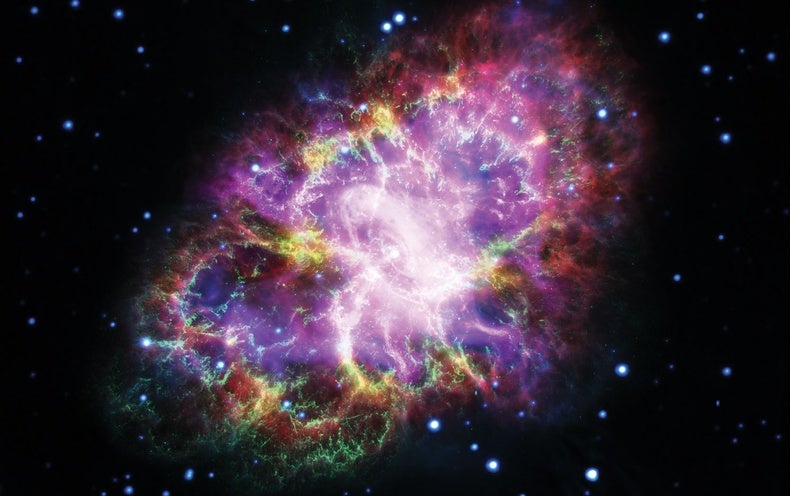After two decades in space, the world's leading x-ray telescope--the Chandra Observatory--is still revealing new secrets of the cosmos
Blast Scene Deep in the heart of the Crab Nebula lies a highly magnetized, rapidly rotating neutron star that was produced when a massive star exploded as a supernova in the year 1054. This multiwavelength image reveals the debris from the blast: x-rays are shown in purple, ultraviolet light in blue, visible in green, infrared in yellow and radio light in red. The x-ray emission, closest to the neutron star, is dominated by light released by charged particles that were accelerated to high energies by the star's rotation. X-ray: NASA, CXC and SAO; Optical: NASA and STSCI; Infrared: NASA, JPL and Caltech; Radio: NSF, NRAO and VLA; Ultraviolet: ESA and XMM-Newton

Belinda J. Wilkes is a senior astrophysicist at the Smithsonian Astrophysical Observatory and director of the Chandra X-ray Center, both in Cambridge, Mass.
In Brief
- This year is the 20th anniversary of NASA’s Chandra X-ray Observatory, which has been continually orbiting Earth since its 1999 launch.
- The telescope has made major discoveries about supermassive black holes, the remnants of supernova explosions, and more.
- As it begins its third decade, Chandra continues to be productive. Planned collaborations with new and existing observatories will further expand our knowledge of the universe.
Since its launch in 1999, NASA’s Chandra X-ray Observatory has been studying the heavens through short-wavelength x-ray light, the best window for sighting colossal black holes, galaxy clusters and the remnants of violent supernovae. The telescope captures the position, energy and arrival time of each x-ray photon that reaches its detector. That ability, in combination with its uniquely sharp imaging quality and capacity to see x-ray light over a broad range of energies, has revolutionized our view of the x-ray universe. It has changed our understanding of big mysteries such as dark matter, the birth of stars and even the properties of the planets in our solar system.
Chandra was designed to solve a key question in x-ray astronomy: What is the makeup of the diffuse x-ray light that appears to be present in every direction of the cosmos--the so-called x-ray background? It was also designed to be a "general observatory," with most of the telescope time awarded to scientists around the world working on diverse projects, chosen after an annual call for proposals. Even after two decades of operation, Chandra receives around 500 to 650 proposals every year, which amounts to about 5.5 times more observing time requested than we have to grant-- the process is highly competitive.

Chandra has been extraordinarily productive. It achieved its original goal by revealing that nearly all of the mysterious x-ray background light comes from thousands of individual supermassive black holes at the centers of other galaxies. It also revealed new secrets from a host of celestial objects: strong x-ray emission from jets of material flying out of supermassive black holes in the process of gobbling up matter; shining aurorae in the atmosphere around Jupiter; light from colliding neutron stars that were also detected through gravitational waves; and extremely bright star-sized black holes aptly named ultraluminous x-ray sources. Science papers based on Chandra observations number more than 8,000, and our user community numbers more than 4,000 scientists worldwide.
I joined the mission three years before launch as deputy group leader for user support. I was involved with building the Web site and documents to provide information for our scientist users, the first call for proposals and peer review, and the calibration of the telescope as it was prepared for launch at NASA’s Marshall Space Flight Center in Alabama. Although this time was busy and stressful as we pulled everything together for liftoff, it was nothing compared with the first few months after launch.
Chandra has reached its 20th anniversary year, and the observatory is still going strong. I serve as director of the Chandra X-ray Center in Cambridge, Mass., where we run the telescope's operations. With telescopes coming online now and in the future, such as the Event Horizon Telescope, the James Webb Space Telescope, and many more, we expect Chandra to continue to forge new ground and further expand our knowledge of the hottest and most violent places in the universe for years to come.
-
Swirling Spirils Two merging galaxies, collectively known as M51, or the Whirlpool, show the beautiful arms characteristic of spiral galaxies. About 400 x-ray sources, most of them binary stars, are visible here, primarily located near regions of star formation. Scientists speculate that the interaction between the two galaxies is triggering a wave of star formation that results in the large number of x-ray binaries in this system. Pulsations from one x-ray binary imply that the compact companion is a neutron star that must be accreting huge amounts of material from its companion to generate its unusually high luminosity. X-RAY: NASA, CXC, WESLEYAN UNIV. AND R. KILGARD ET AL.; OPTICAL: NASA AND STSCI
-
Flying Jet Early in its tenure Chandra observed the quasar PKS 0637-752, a supermassive black hole in the nucleus of a distant galaxy and one that I had studied a decade before, using data from NASA’s Einstein Observatory. The black hole is pulling in massive amounts of material from its host galaxy. As the material falls, it becomes so hot that it outshines the galaxy's 100 billion stars. The extended light on the west (right-hand) side was a surprise and initially had the Chandra staff concerned that something had gone wrong with the telescope optics. Instead Chandra had discovered x-ray emission from a jet of plasma flying out of the infalling matter. This jet had previously been sighted in radio light, but the x-rays were unexpected. Chandra's ability to see the jet as well has resulted in major advances in our understanding of jets emanating from the poles of supermassive black holes. NASA, CXC AND SAO
-
Smoking Gun Among Chandra’s most famous results is this composite image of the Bullet Cluster--a pileup of two galaxy clusters smashing together. The picture combines data from Chandra, Magellan and the Hubble Space Telescope. Here hot gas appears in x-ray light (shown in pink), whereas galaxies can be seen in visible light (white) from Magellan. From the visible-light image scientists infer the distribution of dark matter (blue) from the distortion of the galaxy images caused by gravity (a process called gravitational lensing). The separation between hot gas and dark matter provided the first direct evidence for the presence of dark matter. It demonstrates that this mysterious stuff does not interact with either itself or regular matter, because it moves with the galaxies, not "seeing" the other matter around it. In contrast, the hot gas interacts and slows down, forming the bullet shape that gives the combined clusters their name. X-RAY: NASA, CXC, CFA AND M. MARKEVITCH ET AL.; OPTICAL: NASA, STSCI, MAGELLAN, UNIV. ARIZONA AND D. CLOWE ET AL.; LENSING MAP: NASA, STSCI, ESO WFI, MAGELLAN, UNIV. ARIZONA AND D. CLOWE ET AL.
-
Closer To Home As well as finding distant supermassive black holes and clusters of galaxies, Chandra has made amazing discoveries within our solar system. These images of Jupiter show x-ray emission from the aurora at the north pole of the planet, a feature unique among the worlds in our solar system. The x-rays, also emitted from the aurora at the south pole, are thought to be generated when magnetic fields funnel particles from the equatorial ring around Jupiter. Chandra observations in 2019, coordinated with NASA’s Juno satellite, which is currently orbiting Jupiter, are expected to provide detailed information on this process. As director, I have been able to facilitate some of these observations by allocating Director's Discretionary Time toward this study. X-RAY: NASA, CXC, UCL AND W. DUNN ET AL.; OPTICAL: SOUTH POLE: NASA, JPL-CALTECH, SwRI, MSSS, GERALD EICHSTÄDT AND SEÁN DORAN; NORTH POLE: NASA, JPL-CALTECH, SwRI AND MSSS
-
Baby Stars More than 1,400 blue and orange points of light here are newly formed stars in this dense nebula, which is visible to the naked eye in the middle of the constellation Orion's sword. Chandra's sharp x-ray vision penetrates the dense gas and dust, revealing the new stars that are hidden from traditional visible-light telescopes. Young stars are hot and violent as gravity pulls in matter, magnetic fields accelerate it, and winds blow it out again as a star forms and begins to shine. X-RAY: NASA, CXC, PENN STATE UNIV., AND E. FEIGELSON AND K. GETMAN ET AL.; OPTICAL: NASA, ESA, STSCI AND M. ROBBERTO ET AL.
-
First Light Chandra's official first light image, of the iconic supernova remnant Cassiopeia A, immediately demonstrated the power of the telescope's high spatial resolution by discovering the long-sought neutron star at the center of this nebula. The dense neutron star, a remnant of the much larger star that exploded around 340 years ago as a supernova, had never been visible before. This image combines Chandra data taken over a period of several years, increasing the visible details of the complex structure. It also uses the observatory's energy resolution to reveal different chemical elements that were created within the star and blown out by the explosion: red color indicates silicon, yellow is sulfur, green shows calcium and purple displays iron. The bluish outer ring in the image is emission from high-energy particles accelerated in the forward shock wave of the explosion--another aspect first discovered by Chandra. NASA, CXC AND SAO
-
Cat's Eye The planetary nebula NGC 6543 famously looks like the eye of a cat. Here an older star has become a red giant and shed its outer layers in puffy, colorful clouds. The hot core left behind will eventually collapse to form a dense white dwarf. The central regions of the nebula are filled with multimillion-degree gas observed by Chandra (blue). Meanwhile a fast wind emanating from the core pushes the ejected material outward, creating the graceful, filamentary structures shown in optical data (red, and purple) by telescopes such as Hubble. The observation revealed the star's receding layers were flying away at four million miles per hour. X-RAY: NASA, CXC, AND SAO; OPTICAL: NASA AND STSCI
-
Flame Nebula The star cluster NGC 2024, buried inside the Flame Nebula about 1,400 light-years from Earth, shows a giant cloud of gas and dust where stars are born. In this photograph, x-rays from Chandra (purple) combine with infrared data from NASA’s Spitzer Space Telescope (red, green and blue) to reveal that hot young stars are found in the center and older stars are on the outskirts. X-RAY: NASA, CXC, PSU AND K.GETMAN, E.FEIGELSON, M.KUHN AND THE MYStIX TEAM; INFRARED: NASA AND JPL-CALTECH
-
Tycho's Supernova After a massive star ran out of fuel and exploded, this object—Tycho's supernova remnant—was born. In this Chandra photograph, low-energy x-rays (red) represent expanding debris from the supernova. And high-energy x-rays (blue) show the blast wave—a front of extremely energetic electrons flying outward. X-RAY: NASA, CXC, RUTGERS UNIVERSITY AND K. ERIKSEN ET AL.; OPTICAL: DSS
